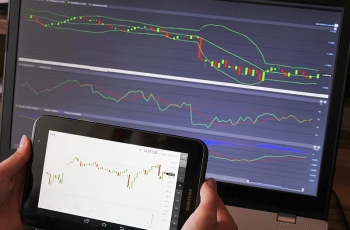Trading Forex involves buying and selling currencies on the foreign exchange market with the aim of making a profit. It is one of the most popular forms of trading due to the market’s liquidity, accessibility, and potential for high returns. However, diving into Forex trading without a solid understanding can lead to significant losses. This comprehensive guide will walk you through everything you need to know as a beginner, from understanding currency pairs to creating a robust trading strategy.
Understanding Forex Basics
Before you place your first trade, it’s crucial to understand the fundamentals of Forex trading. This market involves trading currency pairs, where one currency is bought and another is sold simultaneously. The price of a currency pair reflects how much of the quote currency is needed to buy one unit of the base currency. Some popular currency pairs include EUR/USD (Euro/US Dollar), GBP/USD (British Pound/US Dollar), and USD/JPY (US Dollar/Japanese Yen).
Forex trading uses specific terminologies that may be unfamiliar to newcomers. Terms like pips, spreads, and leverage are commonly used in trading. A pip is the smallest unit of price movement in a currency pair, representing a change of 0.0001 in most pairs (or 0.01 for pairs involving the Japanese Yen). Spreads refer to the difference between the buying (bid) and selling (ask) prices of a currency pair, and it often serves as a transaction cost.
Leverage, on the other hand, allows traders to control larger positions with a relatively small amount of capital, potentially amplifying both profits and losses. For example, a leverage of 100:1 means that for every $1 of your own money, you can control a position worth $100. While leverage can increase the potential for gains, it also comes with heightened risk.
Choosing a Reliable Forex Broker
Once you grasp the basics, the next step is to choose a reputable Forex broker. A broker acts as a bridge between you and the Forex market, executing buy and sell orders on your behalf. It’s crucial to select a broker that offers a reliable and user-friendly trading platform suited for your needs. Look for brokers that are regulated by reputable financial authorities, such as the Financial Conduct Authority (FCA) in the UK or the Commodity Futures Trading Commission (CFTC) in the US. This regulation ensures that the broker adheres to strict standards and protects your investments.

Other factors to consider include the range of currency pairs available for trading, transaction costs (spreads and commissions), and the availability of customer support. Additionally, some brokers offer educational resources, webinars, and market analysis tools that can be valuable, especially for beginners.
Developing a Solid Trading Strategy
Having a well-defined trading strategy is the cornerstone of successful Forex trading. A good strategy combines technical analysis, which involves analyzing past market data and price charts, with fundamental analysis, which focuses on economic indicators and global events. This dual approach allows traders to predict market movements with greater accuracy.
Technical Analysis: Technical analysis relies on charts and indicators to identify patterns and trends. Common indicators include moving averages, Bollinger Bands, and the Relative Strength Index (RSI). Each indicator provides different insights. For instance, moving averages help traders identify the direction of a trend, while Bollinger Bands highlight volatility and potential overbought or oversold conditions. Understanding how to interpret these indicators can help you time your entries and exits effectively.
Fundamental Analysis: Fundamental analysis examines economic indicators such as Gross Domestic Product (GDP) growth rates, inflation statistics, and employment figures. These indicators provide insights into a country’s economic health and often influence central bank policies. Changes in interest rates, for instance, can have a significant impact on a currency’s value. If a central bank raises interest rates, it typically strengthens the currency as higher interest rates attract more foreign capital. Conversely, lowering interest rates may weaken a currency.
Combining these analyses can enhance your trading strategy. For example, if you see a bullish pattern in technical analysis and fundamental analysis indicates strong economic growth, you might have a higher probability of success in your trade.
Effective Risk Management
Risk management is an essential aspect of Forex trading. Even the most experienced traders encounter losses, but managing those losses can mean the difference between long-term success and failure. One of the most critical tools for risk management is the stop-loss order. A stop-loss order automatically closes a trade at a predetermined price level, limiting potential losses. For instance, if you buy EUR/USD at 1.1000 and set a stop-loss at 1.0950, your trade will close automatically if the price drops to 1.0950, minimizing your loss.
Another aspect of risk management is position sizing, which involves determining the amount of capital to risk on each trade. A general rule of thumb is to risk no more than 1-2% of your total trading capital on a single trade. By doing so, you protect your account from significant drawdowns and ensure that you can withstand a series of losses without depleting your capital.
Lastly, leverage should be used cautiously. While leverage can increase your potential gains, it can also amplify losses. It’s advisable for beginners to start with lower leverage ratios until they become more comfortable with their trading strategies.
Staying Informed About Market News and Events
The Forex market is highly sensitive to economic indicators and global news events. Staying updated on these factors is crucial, as they can cause significant volatility in currency prices. Some key economic indicators to monitor include:
- GDP Growth Rates: GDP measures a country’s economic performance. Strong GDP growth often leads to a stronger currency, as it indicates a healthy economy.
- Inflation Rates: Inflation affects a currency’s purchasing power. Central banks may raise interest rates to combat high inflation, leading to a stronger currency.
- Employment Data: High employment levels generally indicate economic strength, which can boost a currency’s value.
In addition to economic indicators, global news events such as geopolitical tensions, natural disasters, or international agreements can have a profound impact on currency prices. For example, a sudden political crisis in a major oil-producing country can lead to fluctuations in the price of currencies related to oil, such as the Canadian Dollar (CAD). Similarly, trade agreements between countries can alter market perceptions and influence currency values.
Practicing With Demo Accounts
As a beginner, it’s advisable to start trading with a demo account. Most brokers offer demo accounts that allow you to practice trading with virtual funds in a simulated environment. This lets you test your strategies and become familiar with the trading platform without risking real money. Demo accounts are a great way to gain hands-on experience and build confidence before transitioning to live trading.
However, be aware that trading in a demo account is different from trading in a live account. The absence of real financial risk in demo accounts can lead to overconfidence or trading behaviors that you wouldn’t exhibit with real money. Therefore, when switching to a live account, ensure you maintain discipline and stick to your trading plan.
Continuous Education and Learning
The Forex market is constantly evolving, and staying ahead requires continuous education. Successful traders often spend time reading books, attending webinars, and taking online courses to deepen their understanding of the market. Some highly recommended books for Forex traders include:
- Trading in the Zone by Mark Douglas
- A Beginner’s Guide to Forex Trading by Matthew Driver
- Technical Analysis of the Financial Markets by John Murphy
Additionally, reputable websites like Investopedia and BabyPips offer free resources that cover everything from beginner basics to advanced trading strategies. Engaging with these resources can provide you with valuable insights and help you refine your trading approach.
Practicing Discipline and Patience
The final piece of advice for Forex trading is to practice discipline and patience. Emotional trading—making decisions based on fear, greed, or impatience—can be a major pitfall for traders. It’s essential to stick to your trading plan, regardless of market conditions. This means adhering to your risk management rules, following your strategy, and not deviating based on emotions.
Patience is equally important. Forex trading is not a get-rich-quick scheme. It takes time to develop the skills and experience necessary for consistent profitability. Set realistic goals and focus on making steady progress rather than aiming for quick wins.
Forex trading offers a wealth of opportunities, but it’s not without challenges. By understanding the fundamentals, choosing a reputable broker, developing a solid trading strategy, managing risk, and staying informed about market developments, you can increase your chances of success. Remember to start with a demo account, continue learning, and practice discipline and patience. With dedication and perseverance, you can navigate the Forex market and potentially achieve your trading goals.




